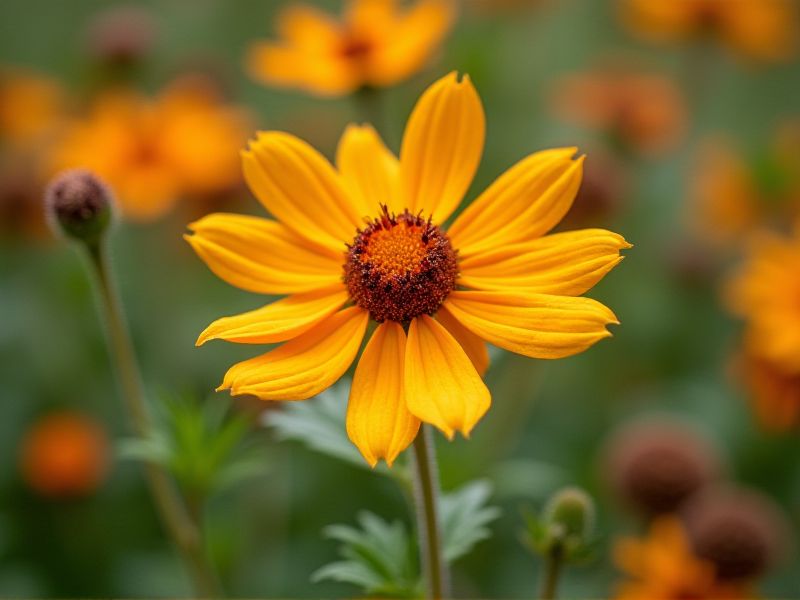
Drought-tolerant flowering plants such as lavender, succulents, and salvia are ideal for water-conscious gardeners seeking vibrant blooms. These resilient species thrive in arid conditions, requiring minimal irrigation while offering stunning colors and scents. Incorporating ornamental grasses, like blue fescue, enhances your garden's texture alongside drought-resistant perennials like coneflowers and bee balm. Native varieties, such as desert marigold, not only support local ecosystems but also bring seasonal beauty with low maintenance. By choosing these plants, you can create a visually appealing landscape that conserves water and promotes sustainability.
List of some Drought-tolerant plants that flower
- Lavender (Lavandula)
- Blanket Flower (Gaillardia)
- Coneflower (Echinacea)
- Russian Sage (Perovskia atriplicifolia)
- Lantana (Lantana camara)
- California Poppy (Eschscholzia californica)
- Bougainvillea (Bougainvillea spectabilis)
- Ice Plant (Delosperma cooperi)
- Rockrose (Cistus)
- Yarrow (Achillea millefolium)
Important things about Drought-tolerant plants that flower
Water-Efficient Species
Drought-tolerant plants that flower, such as Agastache, Echinacea, and Salvia, are ideal for water-efficient gardens. These species not only withstand arid conditions but also provide vibrant blooms, attracting pollinators like bees and butterflies. Planting these hardy varieties can reduce the need for irrigation while enhancing the aesthetic appeal of your landscape. Incorporating xeriscaping principles can maximize the benefits of these plants, promoting sustainability in urban gardens.
Soil Adaptability
Drought-tolerant plants, such as lavender and yarrow, thrive in poor soil conditions and require minimal water, making them ideal for arid climates. These resilient species often possess deep root systems, allowing them to access moisture from deeper layers of the soil, ensuring survival during dry spells. By incorporating these flowering plants into your garden, you can create a vibrant landscape while promoting water conservation and reducing maintenance needs. Their ability to adapt to various soil types emphasizes the importance of selecting the right plants for sustainable gardening practices.
Sunlight Requirements
Drought-tolerant flowering plants thrive in full sun environments, requiring at least six to eight hours of direct sunlight each day. Varieties such as the desert marigold, yarrow, and black-eyed Susan not only adapt to dry conditions but also bring vibrant color and life to arid landscapes. These plants often possess specialized adaptations, like deep root systems and waxy leaves, allowing them to conserve moisture effectively. Choosing these resilient species for your garden can enhance its beauty while minimizing water usage significantly.
Blooming Seasons
Drought-tolerant plants that bloom are essential for creating vibrant gardens in arid climates. Species such as lavender, succulents, and desert marigolds thrive in low-water conditions while providing a burst of color. These plants have adapted to conserve moisture, often featuring waxy leaves or deep root systems that allow them to flourish even during dry spells. Incorporating these resilient flowers into your landscape not only enhances beauty but also contributes to sustainable gardening practices.
Pest Resistance
Drought-tolerant plants that flower, such as the Mexican sage (Salvia leucantha) and blanket flower (Gaillardia), are excellent choices for gardeners seeking vibrant landscapes that require less water. These resilient species not only thrive in arid conditions but also exhibit enhanced pest resistance due to their tough foliage and aromatic properties. By incorporating these plants into your garden, you create a sustainable ecosystem that attracts beneficial pollinators while minimizing the need for chemical pest control. Such flowering plants not only add beauty but also promote biodiversity, making them a wise investment for eco-conscious gardeners.
Native Plant Options
Drought-tolerant native plants that flower provide vibrant color and essential habitat while conserving water resources. For example, the California poppy (Eschscholzia californica) showcases brilliant orange blooms and thrives in arid conditions, making it both beautiful and low-maintenance. Another excellent choice is the purple sage (Salvia leucophylla), which attracts pollinators with its fragrant purple flowers and is well-adapted to dry environments. Incorporating these flowering plants into your garden not only promotes biodiversity but also supports ecosystems resilient to climate change.
Maintenance Needs
Drought-tolerant plants that bloom vibrantly offer a stunning solution for sustainable gardening while conserving water. Popular varieties include the resilient lavender, known for its fragrant purple flowers and ability to withstand arid conditions, and the striking California poppy, which brightens landscapes with its cheerful orange hue. You can enhance your garden's aesthetic with succulents like the vibrant Echeveria, which not only requires minimal water but also adds unique shapes and textures. Regularly mulching around these plants helps retain soil moisture and reduces competition from weeds, ensuring your flowering garden thrives despite dry spells.
Color Variety
Drought-tolerant plants that flower bring vibrant color to arid landscapes while requiring minimal water. Varieties such as the vibrant red desert rose and the cheerful yellow coreopsis thrive in dry conditions, creating a stunning contrast against the earth's palette. Succulent perennials like agaves and aloes not only conserve moisture but also produce striking flowers, attracting pollinators to your garden. By selecting drought-resistant species, you can enhance your outdoor space's beauty while promoting sustainable gardening practices.
Pollinator Attraction
Drought-tolerant flowering plants play a significant role in attracting pollinators such as bees, butterflies, and hummingbirds, especially in arid regions. Plants like lavender, salvia, and yarrow thrive under low-water conditions while providing vibrant blooms that offer nectar and pollen for these crucial species. By incorporating these drought-resistant varieties into your garden, you not only enhance its visual appeal but also create a sanctuary that supports local ecosystems. Choosing native plants can further optimize pollinator activities, ensuring your garden remains a flourishing habitat even during dry spells.
Heat Tolerance
Drought-tolerant plants that flower, such as lavender, rudbeckia, and salvia, are ideal for gardens in hot and arid climates. These resilient plants have adapted to thrive with minimal water, showcasing vibrant blooms even during dry spells. Your choice of drought-tolerant varieties not only conserves water but also supports local ecosystems by attracting pollinators like bees and butterflies. Incorporating these heat-tolerant flowering plants enhances the aesthetics of your outdoor space while promoting sustainable gardening practices.
